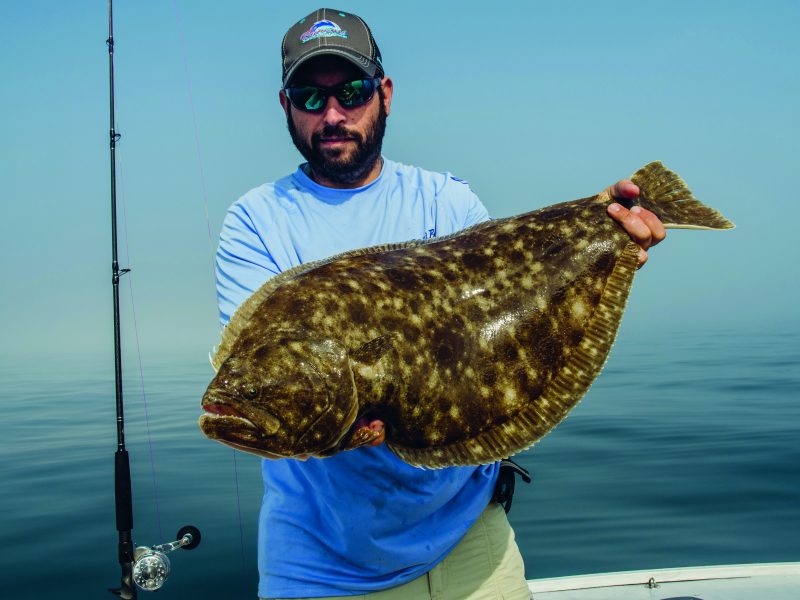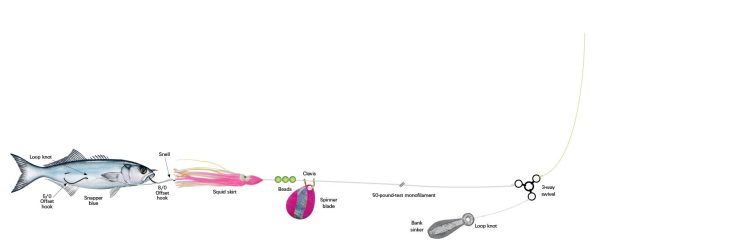Catch Doormat Fluke with Snapper Bluefish
Scaling up your live baits can help you beat the dog days of summer and land some trophy fluke.

The uptick in the tempo of the tailbeats, ever so slight, snapped me back into reality from the late morning, heat-induced daydream that had consumed me for the better part of the drift. I jumped to attention, rod tip lowered to just above the water as my anticipation grew in direct correlation to the increasingly erratic drumming I felt through the braid. Then, THUMP! My rod doubled and the tip was pulled below the surface. I waited a beat, two, then three before finally driving the hook home with an aggressive hookset. Several minutes later, after a brief but nerve-wracking struggle, an 8-pound doormat fluke was in the net, the tail of my snapper blue hanging out of its mouth.
I began fishing for fluke with live “skipjack” (the Rhode Island nickname for juvenile or “snapper” bluefish) about five years ago in an experiment that was the result of several factors. First, I have long thought that summer flounder are much more aggressive than people give them credit for. Contrary to the image of a passive bottom feeder who waits for meals to float by, experience had led me to believe that fluke are proactive predators, following shoals of bait migrating up and down the shore. Big fluke are more than willing to shoot up off the bottom to secure their prey, and I wanted to see just how big of a bait they were willing to take. Additionally, as regulations became increasingly strict, I needed a way to weed through the dozens of short fish that were more than happy to take my traditional fluke rig. Running through a wrap of squid with nothing in the cooler to show for it was getting increasingly frustrating. Lastly, I love fishing with live bait. Nothing compares to the feeling of my bait getting chased down and caught by my target and “seeing” the whole scene play out through my thumb and finger on the line.
While the idea seemed great, there was still a logistical problem that needed to be worked through. I knew a traditional fluke rig would not be effective because the bait was simply too large. To solve the problem, I took inspiration from the live bait rigs used in Florida for snapper and grouper using live cigar minnows. After many hours spent looking at forums and poring over YouTube videos, I devised a rig that I think is the most effective way to fish large live baits for fluke.

The Skipjack Fluke Rig
To tie the rig, cut about a 3-foot piece of 50-pound-test monofilament leader material. Using a loop knot, tie a 5/0 offset hook to the end of the leader. It is important to use a loop knot here, as the extra range of motion makes it easier to position the hook through the skin of the bait and poke it back out to expose the tip.
Next, take a larger, 8/0 offset hook and thread the leader through the eye of the hook. Take a shorter piece of leader and snell the hook to the main leader. The beauty of snelling the hook to the leader with the leader running through the eye of the hook is that it allows your to slide the hook up and down the line to adjust to the size of your bait. The snell keeps the hook snug on the leader but still allows for adjustments so that the distance between the two hooks always perfectly fits the bait.
After the hook is snelled, add a large squid skirt, several beads, and a spinner before finishing the rig with a three-way swivel. From the three-way, tie a tagline with a loop that allows you to switch out the size of the weight quickly and easily while you are fishing.
When the day finally came to try out this newfangled technique, I was nervous. There were years of conventional wisdom suggesting it wouldn’t work and that I’d be better off fishing with tried-and-true strips of squid or fluke belly. However, my fears were quickly put to rest, as the first drift yielded a solid, 5-pound fish. As the day wore on, my companions and I continued to pick away at fish, finishing the trip with six legal fish between the three of us, all between 5 and 8 pounds. The day was an absolute success and one of the best trips in terms of numbers of fish that I have caught when fishing large live baits for flounder.
Since that first trip, it has become an annual tradition once the skipjack, shad, or mackerel arrive. I load up the livewell and head out to target doormats, a tradition that produces the biggest fluke of the year, season after season.
Snapper blues seemed like the logical choice when I first began live-baiting for big flounder because, at the time, bluefish were still an unregulated species, were readily available, and on my ultralight trout setup, they were almost as fun to catch as the flounder. That said, heading out on a trip with just three baits per person, even when quality is prioritized over quantity, is not an ideal situation. Thankfully, any live bait of a similar size works. I have had seasons in which small, 5- to 8-inch shad have come up into Point Judith Pond, and I was able to catch them with the same techniques used for snapper blues. Tinker mackerel, too, would be effective and have been incredibly abundant the past several seasons. To rig the bait, just snip the bait’s tail, put the front hook through its nostrils, and position the stinger about two-thirds of the way down the bait’s body toward the tail. Make sure the back hook is right under the bait’s skin and pops back out so that the point is exposed—the more superficial the better, as this keeps the bait alive longer and allows for the most natural presentation.
There are certain drawbacks to using large, live baits for fluke, namely that it is a calculated decision to trade numbers for quality. There are simply not that many fish big enough to take a live skipjack or other large bait, so this is not the type of “easy” bottom fishing with constant action that many anglers are used to. In light of this, I almost exclusively fish with large, live baits for flounder over hard, rocky bottom. This is not to say that you should head to your favorite tautog rock pile; instead, concentrate on reefs and stretches of rock or gravel bottom. Larger fluke generally prefer to stay around structure since there is more forage and they have less of a need to bury themselves in the sand; as they grow larger, their fear of predation shrinks. To avoid losing my rigs, I fish the bait about a foot off the bottom. Fluke that are large enough to take a snapper won’t hesitate to move up a little in the water column for an easy meal.
One benefit to fishing these nontraditional fluke spots with live bait is that you can catch fluke on days when conditions are less than perfect. Many anglers prefer to fish sandy bottoms with a drift between 0.75 and 1.5 knots, so they won’t go after fluke if those drift conditions are not met. Large, live baits are actually more effective with slower drifts because it is easier to keep them straight up and down. This makes line and depth control easier as you try to keep your bait just off the bottom. In turn, this prevents the snags that cause so many people to avoid drifting over hard bottom for fluke. Additionally, the vibrations from the live bait are enough to entice the fluke to feed even if the tide is not running very hard. I have landed legitimate Joes fishing live skipjack even at slack tide. Big fluke simply cannot resist these large, live baits.
When the snapper blues and small shad arrive this summer and the beaches are paved with undersized fluke, do yourself a favor and fill up your livewell and break away from the fleet that is drifting along flat, sandy bottom. Find some hard structure and send a skipjack down. The feeling of your bait getting nervous and the thump of the doormat that just inhaled it is absolutely addictive. I guarantee it will be well worth the time spent tying rigs. Once you land that first fluke on a large, live bait, you won’t want to do it any other way.
Related Content
10 Reasons You Haven’t Caught a 10-Pound Doormat Fluke
6 Rigs to Know for Fluke Season
5 on “Catch Doormat Fluke with Snapper Bluefish”
-
D.M. Snapper blues as bait for big fluke and weakfish is nothing new, but you should know that regardless of size, there is a finally a take limit on bluefish, so don’t “fill up your live well”
-
b marks more nonsense’s with snappers counting I could Catch more than that off the shore. why are fisherman afraid to speak up. more blues then I’ve seen in 20 years. 3 limit come on
n -
Danny Rangle That’s nothing new. Been using that rig for decades on the West Coast. It’s called a “Hoochie Spinner Rig”.
-
Garrett Friedrichsen Substitute peanut bunker? Seems like using a non-gamefish would be a good choice.
-
Fishwish Catch some nice choggies they live longer no limit and work as good or better
Leave the snappers alone let them grow to gators
Leave a Reply